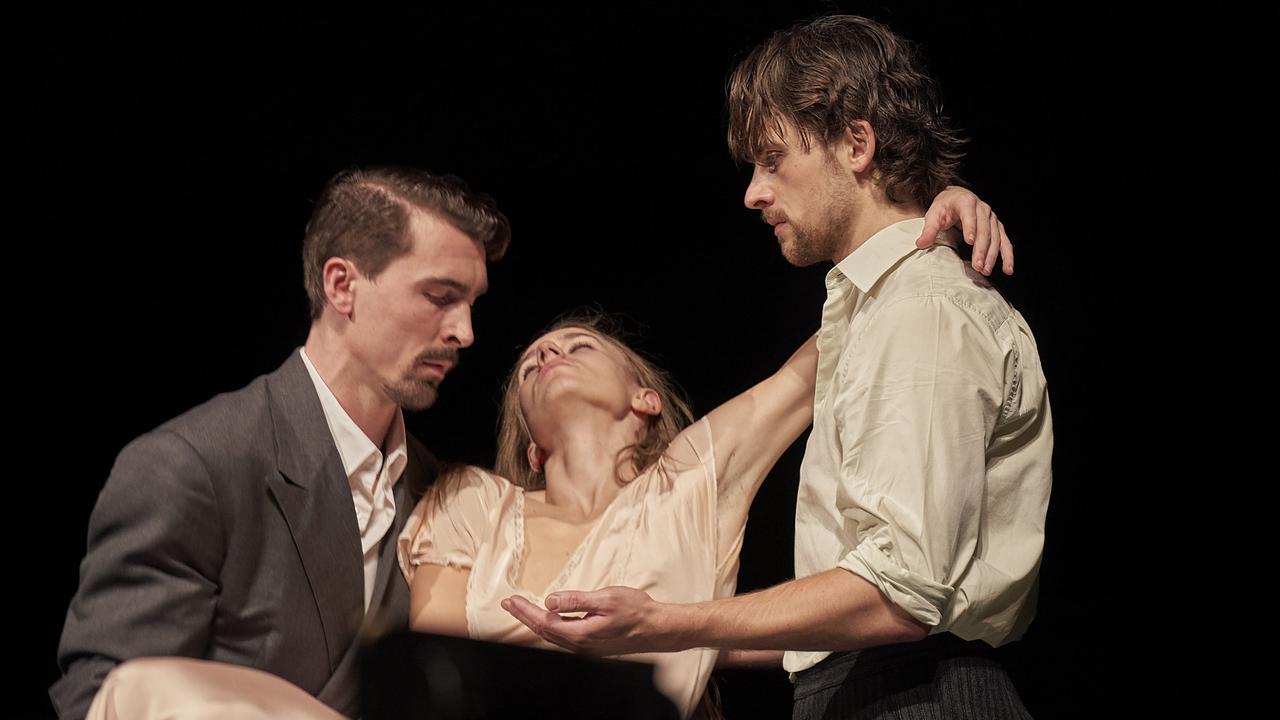Music reviews: Matthew Sheens; Malcolm Williamson; Flamenco; Joe Bonamassa; Shihad
ADELAIDE jazz pianist Matthew Sheens’s new album, Untranslatable, continues his compositional excursions into semi-classical forms.

ADELAIDE jazz pianist Matthew Sheens’s new album, Untranslatable, continues his compositional excursions into semi-classical forms.
JAZZ
Untranslatable
Matthew Sheens
Independent
4 stars
SINCE leaving Adelaide in 2009 to study for a masters at New England Conservatory in Boston, already with a bachelor of music from the Elder Conservatorium, pianist Matthew Sheens has gone from strength to strength. This follow-up to his acclaimed 2013 release, Every Eight Seconds, was also recorded in New York.
The new collection, Untranslatable, continues the pianist’s compositional excursions into semi-classical forms, using the Yanni Burton String Quintet on four tracks, blended into swinging interludes from piano, bass and drums. Sheens’s other interest, also evident in the previous album, is the inclusion of vocal arrangements flawlessly performed on both albums by Portuguese vocalist Sara Serpa in mostly wordless mode. Two other performers from the earlier album are present: bassist Linda Oh and percussionist Rogerio Boccato. There are some fine guitar solos from Mike Moreno, especially a fast-flowing sequence after a unison passage with the vocalist on Depaysement.
Male vocalist Michael Mayo appears on three tracks, including an impressive interpretation of the standard Old Devil Moon with just Sheens’s imaginative solo piano accompaniment. Sheens’s original Madrugada tosses a Latin classical theme back and forth between piano and string quintet, interspersed with some quick bass patterns and adds an excursive guitar solo punctuated by percussion and Ken Walters’s drum kit. Another Latin piece, Alfonsina y el Mar, by famed Argentinian composer Ariel Ramirez, is a sad tribute to poet Alfonsina Storni, who drowned in 1938, and features Spanish lyrics delicately delivered by Serpa. There are two shortish Interludes on the album, both solo piano pieces suffused with classical influences. The title track opens with a staccato attack from the strings, soon giving way to the jazz trio’s rhythmic passage, but strings return to provide occasional backdrops and build to the quintet’s robust, rapid-fire conclusion.
This is a most unusual and varied album containing elements of rhythmic jazz improvisation, semi-classical modes, vocalists plus a wide range of instruments. Sheens is a fine pianist capable of swinging solos and introspective moods, and his compositions show a high level of ability. His achievements are recognised by his inclusion as one of four finalists in the highly regarded 2014 Freedman Fellowship Awards. This year’s prestigious award was decided on August 20 in play-off concerts at the Sydney Opera House. The $15,000 prize was awarded to Aaron Choulai, a pianist from Melbourne now living in Japan. Choulai intends to release a new album in October. The other finalists were trombonist Shannon Barnett from Melbourne, who spent time working in New York before being offered a full-time position in the WDR Big Band in Cologne, Germany, and well-known Melbourne vocalist Gian Slater.
John McBeath
ALSO REVIEWED
CLASSICAL
The Complete Piano Concertos
Piers Lane, Tasmanian Symphony Orchestra
Hyperion
4.5 stars
AUSTRALIAN composer Malcolm Williamson studied piano, violin, french horn and composition in Sydney before moving to London, where he gained prominence as a composer-performer. Williamson’s tastes were broad and his compositions reflect that. In 1975 he became the first non-Briton to be appointed master of the Queen’s music, a post he held until his death in 2003.
This two-album set contains his four piano concertos, a concerto for two pianos and strings, and a sinfonia concertante for piano, three trumpets and strings. Another London-based Australian musician, Piers Lane, brings energetic vitality to the solo piano parts, playing with characteristic flair and authority, and is expertly supported by the Tasmanian Symphony Orchestra with Howard Shelley conducting.
The second concerto, which was written in eight days, flows effortlessly with its sparkling rhythms, charming Gershwin-like touches and playful virtuosity. The third concerto is the most substantial, a four-movement work of 30 minutes that includes a complex and disconcertingly intense scherzo. The slow movement establishes an air of calmness that is shattered by emotionally charged outbursts from the brass.
The exuberant finale resolves any lingering tensions with its thrilling interplay between piano and orchestra. Receiving its first public airing here, the fourth concerto from 1994 retains all the engaging vitality and good humour of Williamson’s more youthful works.
Mark Coughlan
FLAMENCO
The Rough Guide to Flamenco Guitar
Various artists
World Music Network/Fuse
4 stars
THE Rough Guide to Flamenco Guitar exhibits sufficient integrity to sate the appetites of all but aficionados. Having only token representation of the great Paco de Lucia, who almost single-handedly legitimised recording and performance of the genre, and nothing from another maestro, Paco Pena, are demerits.
On the credit side, the compilation amply reflects the ongoing evolution of guitar playing in this passionate, Gypsy-generated Andalusian art form through a range of traditional palos (forms). Authentic solo interpretations of taranta and solea by Miguel Angel Cortes and Jesus de Rosario — the former encasing an elegant tremolo study — should appease purists. A brace of bulerias delivered via swiftly arpeggiated passages and razor-sharp rasgueado (strum) in successive tracks by Moraito and Pepe Habichuela, with palmas (handclap) accompaniment, illustrate why that fast 12-beat arrangement so excites.
Rumba, the bright and breezy rhythm popularised by the Gipsy Kings, is well represented by groups led by Pepe Justicia and Miguel Rivera. Saxophone lends jazz colouring to a rondena performed by teenage prodigy Amos Lora. Fretless electric bass and percussion underpins a tangos by the renowned Tomatito and leads in a funky track from Carles Benavent (with the aforementioned de Lucia in a subsidiary role). Double bass earths Agustin “Bola” Carbonell’s Retrato (Fandangos por Buleria). Violin adds value to Rafael Riqueni’s alegrias and Ignacio de Amparo’s equally expressive, slowed-down sevillanas. A bonus disc, showcasing the talents of Antonio Rey as both guitarist and bandleader, also covers the gamut of flamenco configurations.
Tony Hillier
BLUES
Different Shades of Blue
Joe Bonamassa
J&R Adventures
4 stars
DESPITE Different Shades of Blue being billed as his first completely original album, Joe Bonamassa manages to sneak in almost 1½ minutes of Hendrix at the start. The eerie instrumental refrains of Hey Baby (New Rising Sun) nicely set the pace for the heavy early-1970s feel of Oh Beautiful!, the real opener on another impressive effort from one of the world’s top rock-blues guitarists.
It has been two years since Bonamassa’s previous solo record, although his collaborations with Beth Hart — including the stunning Live in Amsterdam album — make it seem like less. His bona fides as a songwriter are well established, despite his penchant on previous recordings for mixing originals with interpretations, and Different Shades of Blue doesn’t disappoint. There’s the gamut of styles we’ve come to expect from a Bonamassa album, from the rocky refrains of Oh Beautiful! to the funky, brass-backed Love Ain’t a Love Song and the blues-rock of Heartache Follows Wherever I Go.
And, of course, there’s the magnificent guitar work, the vocals and an energy that gives the album a foot-stomping live vibe on tracks such as I Gave Up Everything for You ’Cept the Blues. It’s spiced with plenty of brass and some nice work on keyboards, particularly on the closing blues ballad So, What Would I Do . It would have been interesting to see Bonamassa follow Hendrix’s lead and take an off-the-wall experimental tack, but maybe that’s one for next time.
The guitarist is no stranger to our shores and he’s back next month for another series of concerts. Given this material, the tour should be a cracker.
Steve Creedy
ROCK
FVEY
Shihad
Warner
4 stars
THERE’S a pleasing sense of circularity to FVEY, the ninth album by New Zealand-born, Melbourne-based rock act Shihad. The quartet has again enlisted Jaz Coleman to produce, just as it did with its 1993 debut, Churn. Coleman was co-founder of lauded British post-punk pioneers Killing Joke, so perhaps it’s no surprise that Churn remains the heaviest album of Shihad’s career — until now. FVEY is raw and calculated, full of searing, down-tuned guitar riffs and bludgeoning rhythms, though a melodic hook is never far away.
The quality of the band’s discography has been inconsistent and defined by an artistic seesawing between those thrash-metal roots and a fondness for pop songwriting. On FVEY, the band leans towards the former. Happily, the writing is strong throughout. The title is pronounced “five eyes”, and refers to the intelligence-sharing alliance between Australia, New Zealand, the US, Britain and Canada. Hot topics in singer-guitarist Jon Toogood’s notebook include the society-wide surveillance that was uncovered with last year’s National Security Agency whistleblower leaks, as well as personal freedom and inequality.
These are lofty ideas for a rock band to consider in three to seven-minute slices, yet the songs bristle with positive energy and righteous indignation. Toogood is clearly pissed off with certain states of affairs, and he’s not afraid to say so; fittingly, his bandmates have outdone themselves to match his fury.
Andrew McMillen


